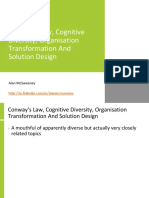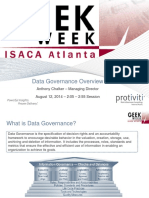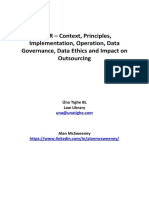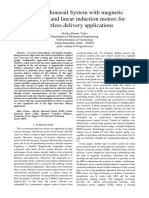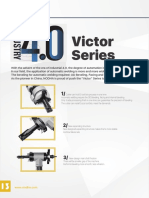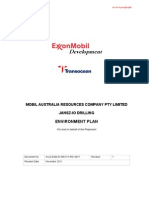Real-Time Data Strategy Guide
Uploaded by
Alan McSweeneyReal-Time Data Strategy Guide
Uploaded by
Alan McSweeneyReal Time Data Strategy And
Architecture
Alan McSweeney
http://ie.linkedin.com/in/alanmcsweeney
Real Time Data Collection Strategy And Architecture
Approach
These notes are concerned with describing a generalised
approach to defining a strategy for collecting (near or
actual) real time, high volume data
This is data is generated by sensors that is transmitted to a
central location for processing, reporting, analysis and
ultimately action
Sensors can be regarded as logical or physical sources of
streams of measurement data
(Near) real time data can be termed Telemetry
March 8, 2016
Real Time Data Collection Strategy And Architecture
Approach
Approach adopted from TMForum Resource Domain
Frameworx eTOM (Enhanced Telecoms Operating Model)
Business Process Framework
Approach has been generalised for real-time data and
telemetry
March 8, 2016
Real Time Data Collection Strategy And Architecture
Collect data from range of data sources across the
organisations (internal and external) operating landscape
Approach can be applied to collection of measurement
data from multiple sources and of multiple types through
sensors:
Different entities interacting with the organisation and the
gathering of data on different actions and events
Approach can be applied to areas such as Telemetry, Big
Data, Smart Metering and Internet of Things
implementations and operations
March 8, 2016
Real Time Data Collection Strategy And Architecture
Real Time Data Strategy
Telemetry
Strategy
SmartX
Strategy
March 8, 2016
Big Data
Strategy
Digital
Strategy
Internet Of
Things
Strategy
Why Have A Real Time Data Collection Strategy And
Architecture?
Real time situational data gives rise to situational
awareness and understanding which in turn presents
opportunities for effective and rapid situational decisions
What is happening usage, performance
What can be improved
What are the optimisation and productivity opportunities
Real time situational data enables greater situational
visibility which means increased operational intelligence
March 8, 2016
Organisation Operating Landscape
March 8, 2016
Organisation Operating Landscape
The operating landscape of the organisation defines the
number and type of interactions outside the organisation
This operating landscape affects the decision on what and
how to measure
Not all interactions with all entities are measured
Need to be realistic about what can be collected and
processed
Need to understand the need for sensors to collect data
March 8, 2016
Data Sensors Combinations Of Options
Sensor Type
Logical
Direct
Sensor Ownership
Indirect
Physical
Web Site and App Activity
and Usage Data
Internet of Things Devices
Remote Real Time Unit
Smart Devices
Third-Party Web Site and
App Activity and Usage
Data
Third-Party Devices
Sensor Type Physical sensors are actual units such as RTUs
(Remote Telemetry Units) that measure and generate data
while Logical sensors are representations of data sources
Sensor Ownership Direct sensors are those installed and
maintained by the collecting organisation while Indirect
sensors are installed by a third-party
March 8, 2016
Measurement Data Sensors
March 8, 2016
10
Measurement Data Sensors
These can gather data for different measures using
multiple measurement techniques
These can be regarded as collectors of any data usage,
activity, performance, throughput
Each measurement type will have a unit or dimension
Logical representation of data collectors
Need to decide on what can be measured, what to
measure and how to measure it
March 8, 2016
11
Measurement Data Sensors Decide On What And
How To Measure
March 8, 2016
12
Real Time Data Architecture Complexity
Real Time Data Architectures
Tend To Focus On The Simplicity
Of A Possible Real Time Data
Collection Architecture
And Ignore The Complexity And
Difficulties Of Sensor Installation,
Operation, Maintenance, Errors,
Rework, Logistics, Service
Management, Data Volumes
March 8, 2016
13
Real Time Data Architecture Complexity
Structured approach is intended to ensure that complexity
is understood and can be appropriately addressed at an
early stage before problems become to embedded to be
solved
March 8, 2016
14
Real Time Data Architecture Complexity
Dont Let The Ignored But
Knowable And Addressable
Complexity Sink Your Real
Time Data
Programme/Initiative
March 8, 2016
15
Real Time Data Strategy And Architecture Issues
What business benefits will a real time data strategy yield?
How can the benefits be realised?
What is the business case for investment in a real time data
strategy?
What infrastructure, communications/connectivity, data and
application architectures are needed to support a real time data
strategy?
What integration is required with existing applications?
What skills, capabilities and changes does the organisation need to
adopt and exploit a real time data strategy?
How is the real time data strategy managed and serviced?
What solution and service providers and tools/platforms and
sourcing strategy should be selected?
What are the privacy and security issues and requirements?
March 8, 2016
16
Evolution Of Real Time Data Architecture
Sense and respond
Fly
Optimising
Processes, mechanisms and
metrics
Run
Managing
Making and implementing
effective investment
decisions
Communicating
Walk
Governing
Admitting
There must be a better way
March 8, 2016
Crawl
Establishing and
communicating business case
Leveraging
for Strategic
Outcomes
Real time data management, reporting and
analysis techniques are deployed for
strategic mission/business outcomes
Improving Real
Time Data
Processes
Process evaluation techniques focus on
improvement of performance and
management
Developing
Complete Real
Time Data
Portfolio
Comprehensive selection and control
processes with benefit and risk criteria
linked to strategy requirements
Building Real Time
Data Investment
Foundation
Implement investment controls and develop
key foundational capabilities
Create Awareness
for Real Time Data
Investment
Undefined/unarticulated/uncertain real time
data strategy. Real time data processes are
ad hoc, focussed on individual solution and
outcomes vary widely.
17
Developing A Real Time Data Strategy Generalised
High Level Steps
1
Real Time
Strategy And
Planning
2
Real Time
Capability
Delivery
Real Time
Provisioning
Real Time
Data
Collection
And
Distribution
March 8, 2016
3
Real Time
Development
And
Retirement
8
Real Time
Problem
Management
4
Real Time
Management
and
Operations
Support And
Readiness
9
Real Time
Performance
Management
5
Workforce
Management
10
Real Time
Data
Aggregation
and
Reporting
18
Developing A Real Time Data Strategy Generalised
High Level Steps
Comprehensive set of steps from definition of what is required
from real time data to commissioning of real time data
collection facilities to effective use of collected data
Not all steps are relevant to all real time data initiatives
For example, if installation, commissioning, operation and maintenance
of physical sensors is not applicable then related steps will not be
required
Represents an idealised organisation and process breakdown
across entire spectrum of real time data from strategy to
workforce management to device installation, data collection
and data usage and actioning
Provides a basis for developing a work breakdown and an
implementation plan
Represents a comprehensive structure that can be adapt to
meet its long-term real time data needs
March 8, 2016
19
Developing A Real Time Data Strategy Generalised
High Level Steps 1 2
Step
Scope
1. Real Time Strategy And
Planning
2. Real Time Capability
Delivery
March 8, 2016
Develop real time data strategy, policies and plans for the organisation governed by long-term
business, market, product and service needs directions
Perform research and analysis to determine real time targets and strategies to reach the defined
targets
Understand the real time data capabilities of the existing infrastructure
Build real time data model
Define approaches to real time data quality and real time data governance
Define and agree the infrastructure needs based on market, product and service strategies of the
organisation
Manage the capabilities of the suppliers and partners to develop and deliver new real time data
capabilities and detail the approach to the deployment of new and enhanced infrastructure
Define the real time data implementation standards sought, key real time data capabilities
required, real time data support levels and approaches required, real time data design elements
to be developed, and real time data cost parameters and targets.
Define the policies relating to technical real time data sensors and their implementation
Ensure that network, application and computing real time data facilities are deployed
Provide the physical real time data capabilities necessary for the ongoing operations and longterm well-being of the organisation and ensure the basis on which all real time data capabilities
and services will be constructed
Plan real time data resource supply logistics
Plan real time data sensor installation
Verify the real time data sensor installation
Handover real time data capabilities to operations
20
Developing A Real Time Data Strategy Generalised
High Level Steps 3 6
Step
Scope
3. Real Time
Development And
Retirement
4. Real Time
Management and
Operations Support And
Readiness
5. Workforce
Management
6. Real Time Provisioning
March 8, 2016
Develop new or enhance existing technologies and associated real time data types applying the
capability definition or requirements defined by the Real Time Strategy And Planning step
Decide on acquisition of real time data resources from third parties
Retire or remove technology and associated real time data resource types that are no longer
needed by the organisation
Manage the types of real time data resources and ensure that necessary application, computing
and network facilities are available and ready to implement and manage resource instances
Manage the direct and indirect personnel who perform work assignments or work orders relating
to real time data resources installation, commissioning and maintenance as well as managing the
actual activity being performed
Report and monitor activities
Establish, manage and allocate work assignments to direct and indirect personnel
Establish and manage priority and urgent assignment capabilities to allow for modification of
work assignments as required to meet urgent and high priority conditions
Allocate, install, configure, activate and test of real time data resources to meet the defined
requirements
Resolve real time resource capacity issues, availability issues or failure conditions
Configure and activate physical and/or logical real time resources
Update of real time resource register database to reflect that the specific real time resource has
been allocated, modified or recovered
21
Developing A Real Time Data Strategy Generalised
High Level Steps 7 8
Step
Scope
7. Real Time Data
Collection And
Distribution
8. Real Time Problem
Management
March 8, 2016
Collect and distribute management information and real time data between data sources and
service instances and other organisation functions and processes
Work with the real time data resource and service instances to collect usage, network and
technology events and other management information for distribution to other processes within
the organisation
Handle and process command, query and other management information for distribution to
resource and service instances
Process the data and management information through actions such as filtering, aggregation,
formatting, transformation and correlation of the information before presentation to other
processes, real time data instances or service instances
Perform usage reporting, fault and performance analysis, service quality management analysis,
resource performance analysis of resources and services
Manage real time data resource problems including security events
Detect, analyse, manage and report on resource alarm event notifications
Initiate and manage real time data resource problems reports
Perform real time data resource problem localization analysis and resolve problems
Reporting progress on resource trouble reports to other processes
Assign and track real time data resource problem testing and resolution activities
Managing real time data resource problem urgent conditions
22
Developing A Real Time Data Strategy Generalised
High Level Steps 9 10
Step
Scope
9. Real Time Performance
Management
10. Real Time Data
Aggregation and
Reporting
March 8, 2016
Manage, track, monitor, analyse and report on the performance of real time data resources
Identify real time data resource performance disruptions or a service performance disruptions
Manage real time data resource events by correlating and formatting them into a usable format
Report of real time data resource data
23
Sample Expansion Step 1 Real Time Strategy And
Planning Activities 1.1 1.7
Step
Scope
1.1 Gather And Analyse Real
Time Data Information
1.2 Manage Real Time Data
Research
1.3 Establish Real Time Data
Strategy And Architecture
1.4 Define Real Time Data
Support Strategies
1.5 Produce Real Time Data
Business Plans
Research and analyse customer, technology, competitor and marketing information to identify
new real time data requirements and industry real time data capabilities and availability.
Manage internally driven research investigations and activities which are used to provide detailed
technical assessment or investigation of new and emerging real time data capabilities.
Establish the real time data strategies based on market trends, future needs, technical
capabilities and addressing shortcomings in existing real time data support.
Define the principles, policies and performance standards for the operational organisation
providing real time data support.
Develop and deliver annual and multi-year real time data plans in support of services,
products and offers that include volume forecasts, negotiation for required levels of resources
and budgets.
Obtain real time data development and management as well as supply chain commitment
and executive approval for the plans.
Identify the impacts that new or modified real time data infrastructure will cause on the
installed infrastructure and workforce and establish the functions and benefits that new or
modified real time data will provide to users.
Identify the requirements for real time data capabilities to be sourced from partners or suppliers,
and any real time data capabilities to be delivered internally to the organisation.
Obtain organisation commitment to the resource strategy and business plans including all aspects
of identification of stakeholders and negotiation to gain stakeholder approval.
1.6 Develop Real Time Data
Partnership Requirements
1.7 Gain Enterprise
Commitment To Real Time
Data Plans
March 8, 2016
24
Sample Expansion Step 1 - Real Time Strategy And
Planning Activity 1.5 Tasks 1.5.1 1.5.5
Step
Scope
1.5.1 Develop And Deliver Develop and deliver annual/multi year real time data business plans focus on developing and
Annual/Multi Year Real
delivering annual and multi-year real time data in support of services, products and offers that
Time Data Business Plans include volume forecasts, negotiation for required levels of resources and budgets, gaining real time
data development and management as well as supply chain commitment and executive approval for
the plans.
1.5.2 Forecast High Level Forecast real time data demand and capture new opportunities processes ensures that budgets are
Real Time Data Demand assigned which allow the organisation to implement the real time data capabilities and capacity
And Capture New
necessary for the future needs of their customers and potential customers.
Opportunities
1.5.3 Assess Impact Of
Asses impact of real time data business plan processes assess the impacts that new or modified real
Real Time Data Business time data infrastructure will cause on the installed infrastructure and workforce, and establish the
Plans
functions and benefits that new or modified real time data will provide to users
1.5.4 Identify Timetables Identify timetables for new real time data capability introduction
For New Real Time Data
Capability Introduction
1.5.5 Identify Logistics For Identify logistics for new real time data capability introduction
New Real Time Data
Capability Introduction
March 8, 2016
25
Real Time Data Quality And Data Governance
Real-time data is inherently:
High Volume lots of sensors generating lots of data
Noisy lots of variation, statistical noise, inaccuracies, sensor drift, errors,
incorrect calibration
Changing data landscape subject to substantial change along the dimensions
of data sources, volumes, types
Inconsistent different sensor types measuring different values with different
units of measure and at different intervals
Heterogeneous very mixed data sources
Non-standardised multiple, emerging, overlapping standards and
approaches
Sophisticated approach to data quality and data governance must be
embedded in any real-time architecture
Traditional approach of data collection storage and analysis may
need to change to handle data volumes and quality data filtering,
quality, summarisation and transformation component
March 8, 2016
26
Real Time Data Principles
To manage and utilise real time information as a strategic asset
To implement processes, policies, infrastructure and solutions to govern, protect,
maintain and use real time information
To make relevant and correct real time information available in all business
processes and IT systems for the right people in the right context at the right time
with the appropriate security and with the right quality
To exploit real time information in business decisions, processes and relations
March 8, 2016
27
Real Time Data And Data Governance And Data
Quality
Data Quality - measure, assess, improve, and ensure the
fitness of data for use
Data Governance - authority and control over the
management of data assets
March 8, 2016
28
Real Time Data Governance
Core function of real time data management
Interacts with and influences each of the surrounding ten data
management functions
Data governance is the exercise of authority and control
(planning, monitoring, and enforcement) over the management
of data assets
Data governance function guides how all other data
management functions are performed
High-level, executive data stewardship
Data governance is not the same thing as IT governance
Data governance is focused exclusively on the management of
data assets
March 8, 2016
29
Real Time Data Governance Definition and Goals
Definition
The exercise of authority and control (planning, monitoring, and
enforcement) over the management of data assets
Goals
To define, approve, and communicate data strategies, policies,
standards, architecture, procedures, and metrics
To track and enforce regulatory compliance and conformance to
data policies, standards, architecture, and procedures
To sponsor, track, and oversee the delivery of data management
projects and services
To manage and resolve data related issues
To understand and promote the value of data assets
March 8, 2016
30
Real Time Data Governance Structure
Real Time Data
Governance Framework
Real Time Data
Architecture to Implement
Data Governance
Real Time Data
Infrastructure to
Implement Data
Architecture
Real Time Data
Operations to Manage
Data Infrastructure
March 8, 2016
31
Real Time Data Governance Activities
Real Time Data Governance
Real Time Data Management Planning
Real Time Data Management Control
Understand Strategic Enterprise Real Time Data
Needs
Supervise Real Time Data Professional Organisations
and Staff
Develop and Maintain the Real Time Data Strategy
Coordinate Real Time Data Governance Activities
Establish Real Time Data Professional Roles and
Organisations
Manage and Resolve Real Time Data Related Issues
Identify and Appoint Real Time Data Stewards
Monitor and Ensure Regulatory Compliance
Establish Real Time Data Governance and
Stewardship Organisations
Monitor and Enforce Conformance withReal Time
Data Policies, Standards and Architecture
Develop and Approve Real Time Data Policies,
Standards, and Procedures
Oversee Real Time Data Management Projects and
Services
Review and Approve Real Time Data Architecture
Communicate and Promote the Value of Real Time
Data Assets
Plan and Sponsor Real Time Data Management
Projects and Services
Estimate Real Time Data Asset Value and Associated
Costs
March 8, 2016
32
Real Time Data Governance Inputs And Outputs
Inputs
Primary Deliverables
Business Goals
Business Strategies
IT Objectives
IT Strategies
Data Needs
Data Issues
Regulatory Requirements
Suppliers
Data Policies
Data Standards
Resolved Issues
Data Management Projects and
Services
Quality Data and Information
Recognised Data Value
Real Time Data
Governance
Data Producers
Knowledge Workers
Managers and Executives
Data Professionals
Customers
Business Executives
IT Executives
Data Stewards
Regulatory Bodies
Participants
Executive Data Stewards
Coordinating Data Stewards
Business Data Stewards
Data Professionals
DM Executive
CIO
March 8, 2016
Consumers
Tools
Intranet Website
E-Mail
Metadata Tools
Metadata Repository
Issue Management Tools
Data Governance KPI
Dashboard
Metrics
Data Value
Data Management Cost
Achievement of Objectives
# of Decisions Made
Steward Representation /
Coverage
Data Professional Headcount
Data Management Process
Maturity
33
Real Time Data Quality Management
Critical support process in organisational change management
Data quality is synonymous with information quality since poor
data quality results in inaccurate information and poor
business performance
Data cleansing may result in short-term and costly
improvements that do not address the root causes of data
defects
More rigorous data quality program is necessary to provide an
economic solution to improved data quality and integrity
Institutionalising and operationalising processes for data
quality oversight, management, and improvement hinges on
identifying the business needs for quality data and determining
the best ways to measure, monitor, control, and report on the
quality of data
Continuous process for defining the parameters for specifying
acceptable levels of data quality to meet business needs, and
for ensuring that data quality meets these levels
March 8, 2016
34
Real Time Data Quality Management Definition
and Goals
Definition
Planning, implementation, and control activities that apply quality
management techniques to measure, assess, improve, and ensure
the fitness of data for use
Goals
To measurably improve the quality of data in relation to defined
business expectations
To define requirements and specifications for integrating data
quality control into the system development lifecycle
To provide defined processes for measuring, monitoring, and
reporting conformance to acceptable levels of data quality
March 8, 2016
35
Real Time Data Quality Management Inputs And
Outputs
Inputs
Primary Deliverables
Business Requirements
Data Requirements
Data Quality Expectations
Data Policies and Standards
Business metadata
Technical metadata
Data Sources and Data Stores
Suppliers
External Sources
Regulatory Bodies
Business Subject Matter Experts
Information Consumers
Data Producers
Data Architects
Data Modelers
Participants
Data Quality Analysts
Data Analysts
Database Administrators
Data Stewards
Other Data Professionals
DRM Director
Data Stewardship Council
March 8, 2016
Real Time Data
Quality
Management
Improved Quality Data
Data Management
Operational Analysis
Data Profiles
Data Quality Certification
Reports
Data Quality Service Level
Agreements
Consumers
Data Stewards
Data Professionals
Other IT Professionals
Knowledge Workers
Managers and Executives
Customers
Tools
Data Profiling Tools
Statistical Analysis Tools
Data Cleansing Tools
Data Integration Tools
Issue and Event Management
Tools
Metrics
Data Value Statistics
Errors / Requirement Violations
Conformance to Expectations
Conformance to Service Levels
36
Real Time Data Quality Plan Definition Activities
Real Time Data Quality Plan Definition
March 8, 2016
1. Develop and Promote Data Quality
Awareness
2. Define Data Quality Requirements
3. Profile, Analyse and Assess Data
Quality
4. Define Data Quality Metrics
5. Define Data Quality Business Rules
6. Test and Validate Data Quality
Requirements
7. Set and Evaluate Data Quality Service
Levels
8. Continuously Measure and Monitor
Data Quality
9. Manage Data Quality Issues
10. Clean and Correct Data Quality
Defects
11. Design and Implement Operational
Data Quality Management Procedures
12. Monitor Operational Data Quality
Management Procedures and
Performance
37
Developing A Real Time Data Strategy Generalised
High Level Steps
10 high level steps with activities and tasks
Over 180 detailed tasks for a complete view of work required
Comprehensive set of steps from definition of what is required from real time data to
commissioning of real time data collection facilities to effective use of collected data
Real Time Data
Strategy and
Implementation
1 Real Time
Data Strategy
And Planning
2 Real Time
Data
Capability
Delivery
3 Real Time
Data
Development
And
Retirement
4 Real Time
Data
Management
and
Operations
Support And
Readiness
5 Workforce
Management
6 Real Time
Data
Provisioning
7 Real Time
Data
Collection
And
Distribution
8 Real Time
Data Trouble
Management
9 Real Time
Data
Performance
Management
10 Real
Time Data
Aggregation
and
Reporting
Activities
Tasks
March 8, 2016
38
Real Time Data Strategy and Implementation
Organisation, Function And Process Structure Steps 1-10
Real Time Data
Strategy and
Implementation
1 Real Time Data
Strategy And
Planning
2 Real Time Data
Capability Delivery
3 Real Time Data
Development And
Retirement
4 Real Time Data
Management and
Operations
Support And
Readiness
5 Workforce
Management
6 Real Time Data
Provisioning
7 Real Time Data
Collection And
Distribution
8 Real Time Data
Trouble
Management
9 Real Time Data
Performance
Management
10 Real Time Data
Aggregation and
Reporting
1.1 Gather And
Analyse Real Time
Data Information
2.1 Map And
Analyse Real Time
Data
Requirements
3.1 Gather And
Analyse New Real
Time Data Ideas
4.1 Enable Real
Time Data
Provisioning
5.1 Manage
Schedules and
Appointments
6.1 Allocate And
Install Real Time
Data
7.1 Collect
Management
Information And
Data
8.1 Survey And
Analyse Real Time
Data Trouble
9.1 Monitor Real
Time Data
Performance
10.1 Aggregate
Real Time Data
Records
1.2 Manage Real
Time Data
Research
2.2 Capture Real
Time Data
Capability
Shortfalls
3.2 Assess
Performance Of
Existing Real Time
Data
4.2 Enable Real
Time Data
Performance
Management
5.2 Plan and
Forecast
Workforce
Management
6.2 Configure And
Activate Real Time
Data
7.2 Process
Management
Information And
Data
8.2 Localise Real
Time Data Trouble
9.2 Analyse Real
Time Data
Performance
10.2 Report Real
Time Data
Records
1.3 Establish Real
Time Data
Strategy And
Architecture
2.3 Gain Real Time
Data Capability
Investment
Approval
3.3 Develop New
Real Time Data
Business Proposal
4.3 Support Real
Time Data Trouble
Management
5.3 Administer
and Configure
Workforce
Management
6.3 Test Real Time
Data
7.3 Distribute
Management
Information And
Data
8.3 Correct And
Resolve Real Time
Data Trouble
9.3 Control Real
Time Data
Performance
1.4 Define Real
Time Data
Support Strategies
2.4 Design Real
Time Data
Capabilities
3.4 Develop
Detailed Real
Time Data
Specifications
4.4 Enable Real
Time Data
Collection And
Distribution
5.4 Report
Workforce
Management
6.4 Track And
Manage Real Time
Data Provisioning
7.4 Audit
Management And
Security Data
Collection And
Distribution
8.4 Track And
Manage Real Time
Data Trouble
9.4 Report Real
Time Data
Performance
1.5 Produce Real
Time Data
Business Plans
2.5 Enable Real
Time Data
Support And
Operations
3.5 Manage Real
Time Data
Development
4.5 Manage Real
Time Data
Inventory
5.5 Manage Work
Order Lifecycle
6.5 Report Real
Time Data
Provisioning
8.5 Report Real
Time Data Trouble
9.5 Create Real
Time Data
Performance
Degradation
Report
1.6 Develop Real
Time Data
Partnership
Requirements
2.6 Manage Real
Time Data
Capability Delivery
3.6 Manage Real
Time Data
Deployment
4.6 Manage
Logistics
6.6 Close Real
Time Data Order
8.6 Close Real
Time Data Trouble
Report Flow
9.6 Track And
Manage Real Time
Data Performance
Resolution
1.7 Gain
Enterprise
Commitment To
Real Time Data
Plans
2.7 Manage
Handover To Real
Time Data
Operations
3.7 Manage Real
Time Data Exit
6.7 Issue Real
Time Data Orders
8.7 Create Real
Time Data Trouble
Report
9.7 Close Real
Time Data
Performance
Degradation
Report
6.8 Recover Real
Time Data
March 8, 2016
39
Step 1 Real Time Data Strategy And Planning
Processes And Functions Details
1 Real Time Data
Strategy And
Planning
1.1 Gather And
Analyse Real Time
Data Information
1.2 Manage Real
Time Data Research
1.1.1 Gather Real
Time Data
Information
1.2.1 Manage Real
Time Data Research
Investigations
1.1.2 Analyse New
Real Time Data
Requirements
1.2.2 Manage
Administration Of
Real Time Data
Research
1.1.3 Analyse To
Develop
New/Enhance Real
Time Data
Requirements
1.2.3 Define Real
Time Data Research
Assessment
Methodologies
1.3 Establish Real
Time Data Strategy
And Architecture
1.5 Produce Real
Time Data Business
Plans
1.6 Develop Real
Time Data
Partnership
Requirements
1.7 Gain Enterprise
Commitment To
Real Time Data
Plans
1.3.1 Establish Real
Time Data Strategy
1.4.1 Define Real
Time Data Support
Principles
1.5.1 Develop And
Deliver
Annual/Multi Year
Real Time Data
Business Plans
1.6.1 Identify The
Requirements For
Real Time Data
Capabilities
1.7.1 Identify
Stakeholders To
Real Time Data
Strategy And Real
Time Data Plans
1.3.2 Develop Real
Time Data Strategy
1.4.2 Define Real
Time Data Support
Policies
1.5.2 Forecast High
Level Real Time
Data Demand And
Capture New
Opportunities
1.6.2 Recommend
Real Time Data
Partnership
1.7.2 Gain Real Time
Data Strategy And
Real Time Data
Plans Stakeholders
Approval
1.3.3 Establish Real
Time Data Delivery
Goals
1.4.3 Define Real
Time Data Support
Performance
Standards
1.5.3 Assess Impact
Of Real Time Data
Business Plans
1.6.3 Determine
Extent Of Real Time
Data Capabilities
Sourcing
1.7.3 Gain
Enterprise
Commitment To
Real Time Data
Strategy And Real
Time Data Plans
1.3.4 Establish Real
Time Data
Implementation
Policies
March 8, 2016
1.4 Define Real
Time Data Support
Strategies
1.5.4 Identify
Timetables For New
Real Time Data
Capability
Introduction
1.5.5 Identify
Logistics For New
Real Time Data
Capability
Introduction
40
Step 2 - Real Time Data Capability Delivery
Processes And Functions Details
2 Real Time Data
Capability Delivery
2.1 Map And
Analyse Real Time
Data Requirements
2.2 Capture Real
Time Data Capability
Shortfalls
2.3 Gain Real Time
Data Capability
Investment
Approval
2.4 Design Real Time
Data Capabilities
2.5 Enable Real Time
Data Support And
Operations
2.6 Manage Real
Time Data Capability
Delivery
2.7 Manage
Handover To Real
Time Data
Operations
2.1.1 Capture Real
Time Data Demand
And Performance
Requirements
2.2.1 Capture Real
Time Data Capacity
Shortfalls
2.3.1 Develop Real
Time Data Capability
Investment
Proposals
2.4.1 Define Real
Time Data Capability
Requirements
2.5.1 Design Real
Time Data
Operational Support
Process
Improvements
2.6.1 Co-Ordinate
Real Time Data
Capability Delivery
2.7.1 Co-Ordinate
Real Time Data
Operational
Handover
2.1.2 Agree Real
Time Data
Infrastructure
Requirements
2.2.2 Capture Real
Time Data
Performance
Shortfalls
2.3.2 Approve Real
Time Data Capability
Investment
2.4.2 Specify Real
Time Data Capability
Infrastructure
2.5.2 Identify Real
Time Data Support
Groups, Skills And
Training
2.6.2 Ensure Real
Time Data Capability
Quality
2.7.2 Validate Real
Time Data
Infrastructure
Design
2.4.3 Select Real
Time Data Capability
At Other Parties
2.5.3 Identify Real
Time Data Support
Requirements
2.6.3 Manage
Commissioning Of
New Real Time Data
Infrastructure
2.7.3 Ensure Real
Time Data Handover
Support
2.2.3 Capture Real
Time Data
Operational Support
Shortfalls
2.6.4 Establish Real
Time Data Capability
Sourcing
March 8, 2016
41
Step 3 - Real Time Data Development And
Retirement Processes And Functions Details
3 Real Time Data
Development And
Retirement
3.1 Gather And
Analyse New Real
Time Data Ideas
3.2 Assess
Performance Of
Existing Real Time
Data
3.3 Develop New
Real Time Data
Business Proposal
3.4 Develop
Detailed Real Time
Data Specifications
3.5 Manage Real
Time Data
Development
3.6 Manage Real
Time Data
Deployment
3.7 Manage Real
Time Data Exit
3.1.1 Gather Real
Time Data
Information
3.3.1 Develop Real
Time Data Business
Proposal
3.4.1 Develop
Detailed Real Time
Data Technical
Specifications
3.5.1 Identify
Required Processes
And Procedures For
Real Time Data
3.6.1 Manage Real
Time Data Process
And Procedure
Implementation
3.7.1 Identify
Unviable Real Time
Data
3.1.2 Analyse Real
Time Data Classes
3.3.2 Gain Real Time
Data Business
Proposal Approval
3.4.2 Develop
Detailed Real Time
Data Support
Specifications
3.5.2 Develop
Required Processes
And Procedures For
Real Time Data
3.6.2 Manage Real
Time Data
Operational Staff
Training
3.7.2 Identify
Impacted Real Time
Data Customers
3.4.3 Develop
Detailed Real Time
Data Operational
Specifications
3.5.3 Develop
Service And
Operational
Agreements For
Real Time Data
3.6.3 Develop Real
Time Data
Supplier/Partner
Operational Support
3.7.3 Develop Real
Time Data Transition
Strategies
3.4.4 Develop
Detailed Real Time
Data Manuals
3.5.4 Gain Service
And Operational
Agreements
Approval For Real
Time Data
3.6.4 Manage Real
Time Data
Acceptance Testing
3.7.4 Manage Real
Time Data Exit
Process
3.1.3 Develop Real
Time Data Classes
March 8, 2016
3.5.5 Produce
Supporting
Documentation And
Training Packages
For Real Time Data
42
Step 4 - Real Time Data Management and Operations
Support And Readiness Processes And Functions Details
4 Real Time Data Management
and Operations Support And
Readiness
4.1 Enable Real Time Data
Provisioning
4.2 Enable Real Time Data
Performance Management
4.3 Support Real Time Data
Trouble Management
4.4 Enable Real Time Data
Collection And Distribution
4.5 Manage Real Time Data
Inventory
4.6 Manage Logistics
4.1.1 Plan And Forecast Real
Time Data Infrastructure
Requirements And Manage
Capacity Planning
4.2.1 Monitor And Manage
Regulatory Issues
4.3.1 Manage Real Time Data
Trouble And Performance Data
Collection
4.4.1 Manage And Administer
Real Time Data Collection And
Distribution
4.5.1 Manage Real Time Data
Inventory Database And
Processes
4.6.1 Manage Warehousing
4.1.2 Establish, Manage, And
Develop Organisetion, Tools And
Processes
4.2.2 Establish And Maintain
Performance Threshold
Standards
4.3.2 Manage Real Time Data
Infrastructure, Provisioning And
Preventive Maintenance
Schedules
4.4.2 Manage Real Time Data
Storage Facilities And Associated
Processes
4.5.2 Track And Monitor Real
Time Data Repository
Capabilities
4.6.2 Manage Orders
4.1.3 Develop And Implement
Capacity And Operational Rules
And Procedures
4.2.3 Undertake Performance
Trend Analysis
4.3.3 Create Report
4.4.3 Track, Monitor And Report
Real Time Data Collection
Processes And Capabilities
4.5.3 Identify Repository Issues
And Provide Reports And
Warnings
4.6.3 Track And Monitor
Logistics And Manage Real Time
Data Inventory
4.1.4 Perform Acceptance Test
And Address And Monitor The
Change
4.2.4 Monitor And Analyse Real
Time Data Performance Reports,
And Identify Issues
4.3.4 Establish Warehouse And
Manage Spares Including Other
Parties
4.4.4 Identify Data Collection
Issues And Report
4.1.5 Track And Supervise The
Rollout Of New And/Or
Modified Infrastructure
4.2.5 Correlate The Performance
Problem Reports And Manage
Inventory Repository
4.3.5 Track, Monitor And
Manage Real Time Data Trouble
Management Processes
Including Other Parties
4.1.6 Monitor, Report And
Release Mgmt. Of Real Time
Data Infrastructure And Capacity
Utilisation
4.2.6 Manage Real Time Data
Performance Data Collection
4.3.6 Provide Support For Real
Time Data Trouble Management
And Support Service Problem
Management Processes
4.1.7 Optimise Existing Real
Time Data Infrastructure
Utilisation
4.2.7 Establish, Maintain And
Manage The Support Plans
4.1.8 Track, Monitor And Report
Real Time Data Provisioning
4.2.8 Assess And Report Real
Time Data Performance
Management Processes
4.1.9 Update Inventory Record
4.2.9 Provide Supporting
Procedures And Quality
Management Support
March 8, 2016
4.6.4 Identify Logistic Issues And
Provide Reports
43
Step 5 - Workforce Management Processes And
Functions Details
5 Workforce Management
5.1 Manage Schedules And
Appointments
5.2 Plan And Forecast
Workforce Management
5.3 Administer And
Configure Workforce
Management
5.4 Report Workforce
Management
5.5 Manage Work Order
Lifecycle
5.1.1 Workforce
Management Schedule
5.2.1 Forecast Demand
5.3.1 Configure Work
Catalog
5.5.1 Issue Work Order
5.1.2 Determine Work
Schedule
5.2.2 Forecast Workforce
Availability
5.3.2 Administer Human
Real Time Data Catalog
5.5.2 Analyse And
Decompose Work Order
5.1.3 Manage Reservations
5.2.3 Adjust Durations
5.3.3 Administer
Organisation's Catalog
5.5.3 Assign Task
5.3.4 Administer Tools And
Materials Catalog
5.5.4 Dispatch Task
5.3.5 Configure Skill Catalog
5.5.5 Track And Manage
Work Order
5.3.6 Configure Schedules
5.5.6 Close Work Order
5.3.7 Administer
Registration And Access
5.5.7 Report On Work Order
5.1.4 Manage Appointments
5.3.8 Configure Logging And
Audit
March 8, 2016
44
Step 6 - Real Time Data Provisioning Processes And
Functions Details
6 Real Time Data
Provisioning
6.1 Allocate And
Install Real Time
Data
6.1.1 Determine
Real Time Data
Availability
6.2 Configure
And Activate
Real Time Data
6.2.1 Configure
Real Time Data
6.3 Test Real
Time Data
6.4 Track And
Manage Real
Time Data
Provisioning
6.7 Issue Real
Time Data
Orders
6.8 Recover Real
Time Data
6.4.1 Coordinate
Real Time Data
Provisioning
Activity
6.5.1 Monitor
Real Time Data
Order Status
6.7.1 Assess
Real Time Data
Request
6.5.2 Distribute
Real Time Data
Order
Notification
6.7.2 Create
Real Time Data
Orders
6.5.3 Distribute
Real Time Data
Provisioning
Reports
6.7.3 Mark Real
Time Data Order
For Special
Handling
6.1.2 Reserve
Real Time Data
6.2.2 Implement
Real Time Data
6.3.2 Develop
Test Plans
6.1.3 Release
Real Time Data
6.2.3 Activate
Real Time Data
6.3.3 Capture
Test Results
6.4.3 Manage
Real Time Data
Provisioning
Activity
6.1.5 Install And
Commission
Real Time Data
6.6 Close Real
Time Data Order
6.3.1 Test
Specific Real
Time Data
6.4.2 Track Real
Time Data
Provisioning
Activity
6.1.4 Allocate
Real Time Data
6.5 Report Real
Time Data
Provisioning
6.4.4 Update
Real Time Data
Repository
6.8.1 Develop
Real Time Data
Recovery Plan
6.8.2 Provide
Real Time Data
Recovery
Proposal
Notification
6.8.3 Request
Real Time Data
Recovery
Authorisation
6.8.4 Commence
Real Time Data
Recovery
6.8.5 Complete
Real Time Data
Recovery
6.8.6 Recover
Specific Real
Time Data
March 8, 2016
45
Step 7 - Real Time Data Collection And Distribution
Processes And Functions Details
7 Real Time Data
Collection And
Distribution
7.1 Collect
Management
Information And Data
7.2 Process
Management
Information And Data
7.3 Distribute
Management
Information And Data
7.4 Audit Management
And Security Data
Collection And
Distribution
7.1.1 Intercept
Events/Information
7.2.1 Determine
Recipients For
Information/Data
7.3.1 Distribute
Information/Data
7.1.2 Deliver
Management
Information
7.2.2 Filter
Information/Data
7.3.2 Manage
Distribution
7.2.3 Aggregate
Information/Data
7.3.3 Confirm
Distribution And CleanUp
7.2.4 Format
Information/Data
March 8, 2016
46
Step 8 - Real Time Data Trouble Management
Processes And Functions Details
8 Real Time Data
Trouble
Management
8.1 Survey And
Analyse Real
Time Data
Trouble
March 8, 2016
8.2 Localise Real
Time Data
Trouble
8.3 Correct And
Resolve Real Time
Data Trouble
8.4 Track And
Manage Real
Time Data
Trouble
8.5 Report Real
Time Data
Trouble
8.6 Close Real
Time Data
Trouble Report
Flow
8.7 Create Real
Time Data
Trouble Report
47
Step 9 - Real Time Data Performance Management
Processes And Functions Details
9 Real Time Data
Performance
Management
9.1 Monitor Real Time
Data Performance
9.2 Analyse Real Time
Data Performance
9.3 Control Real Time
Data Performance
9.4 Report Real Time
Data Performance
9.5 Create Real Time
Data Performance
Degradation Report
9.6 Track And Manage
Real Time Data
Performance Resolution
9.7 Close Real Time Data
Performance
Degradation Report
9.1.1 Manage Real Time
Data Performance Data
9.2.1 Perform Specific
Real Time Data
Performance Diagnostics
9.3.1 Instantiate Real
Time Data Performance
Controls
9.4.1 Monitor Real Time
Data Performance
Degradation Report
9.5.1 Generate Real Time
Data Performance
Degradation Problem
9.6.1 Coordinate Real
Time Data Performance
9.1.2 Record Real Time
Data Performance Data
9.2.2 Manage Real Time
Data Performance Data
Collection Schedules
9.3.2 Instantiate Real
Time Data Trouble
Controls
9.4.2 Distribute Real
Time Data Quality
Management Reports
And Summaries
9.5.2 Convert Report To
Real Time Data
Performance
Degradation Report
Format
9.6.2 Request Other
Parties Performance
Degradation Report
Creation And Update
9.1.3 Correlate Real Time
Data Performance Event
Notifications
9.6.3 Update First In Real
Time Data Testing
Results
9.6.4 Cancel Real Time
Data Performance
Degradation Report
9.6.5 Escalate/End Real
Time Data Performance
Degradation Report
9.6.6 Clear Real Time
Data Performance
Degradation Report
Status
9.6.7 Engage External
Party Real Time Data
March 8, 2016
48
Step 10 - Real Time Data Aggregation And Reporting
Processes And Functions Details
10 Real Time Data
Aggregation And
Reporting
10.1 Aggregation
Real Time Data
Records
10.2 Report Real
Time Data Records
10.1.1 Validate
Real Time Data
Records
10.1.2 Normalise
Real Time Data
Records
10.1.3 Convert
Real Time Data
Records
10.1.4 Correlate
Real Time Data
Records
10.1.5 Remove
Duplicate Real
Time Data Records
March 8, 2016
49
Using Real Time Data Strategy and Implementation
Approach
Timeline
Activity
Real Time Data Strategy and Implementation Plan
1 Real Time Data Strategy And Planning
1.1 Gather And Analyse Real Time Data Information
1.1.1 Gather Real Time Data Information
1.1.2 Analyse New Real Time Data
Requirements
1.1.3 Analyse To Develop New/Enhance Real
Time Data Requirements
1.2 Manage Real Time Data Research
1.2.1 Manage Real Time Data Research
Investigations
1.2.2 Manage Administration Of Real Time
Data Research
1.2.3 Define Real Time Data Research
Assessment Methodologies
1.3 Establish Real Time Data Strategy And
Architecture
1.3.1 Establish Real Time Data Strategy
1.3.2 Develop Real Time Data Strategy
1.3.3 Establish Real Time Data Delivery Goals
1.3.4 Establish Real Time Data
Implementation Policies
1.4 Define Real Time Data Support Strategies
1.4.1 Define Real Time Data Support
Principles
1.4.2 Define Real Time Data Support Policies
1.4.3 Define Real Time Data Support
Performance Standards
March 8, 2016
50
Using Real Time Data Strategy and Implementation
Approach
Use the proposed work breakdown to produce a detailed
plan
March 8, 2016
51
Real Time Architecture High-Level Components
Data Sources
Data Collection
And Data Source
Management
Communications
And Security
Data Quality/
Summary/
Filter/
Transformation
Data Storage
Data Storage
Infrastructure
Data Reporting
and Analysis
External
Systems (Asset
Management,
Workforce
Management)
System
Management,
Administration
and Control
March 8, 2016
Data
Integration
52
Real Time Architecture High-Level Components
Component
Description
Data Sources
These are the data collection/generation sources/sensors installed in the data collection landscape and new
sensor devices and signal data sources. Over time the approach to data collection may be standardised and old
equipment replaced.
This logical component acts as a local front-end to existing signal data collection/generation sources/sensors. It
eliminates the need to replace existing devices. It offers a standard interface. It manages the sensor
infrastructure and landscape
Data Collection And
Data Source
Management
Communications And
Security
Data Integration
Data Quality/
Summary/ Filter/
Transformation
Data Storage
Data Storage
Infrastructure
This is the communications infrastructure used to securely transmit remotely collected data from local data
sources/sensors and data collection units to the central facility.
This component manages the receipt of multiple data types in multiple formats from multiple data sources.
This component applies data quality algorithms to intrinsically noisy real time data to make it more usable.
Data may be filtered, summarised and transformed prior to storage
This is the software component for storing in a structured manner and providing access to real time data.
This is the underlying data storage infrastructure. The volumes of real time data are potentially very substantial
hundreds of millions of data points per day. The data storage requirements could amount to thousands of
Terabytes over several years. This components includes facilities for backup, recovery, archiving and deletion.
This component provides facilities to manage, administer and control the overall real time system.
System Management,
Administration and
Control
This provides reporting and analysis facilities to meet a wide variety of business requirements.
Data Reporting and
Analysis
Real time data can be merged with other data such as asset to provide a usage dimension to static asset data
External Systems
and to integrate with workforce management to manage sensor infrastructure.
March 8, 2016
53
Possible Approaches To Real Time Data Architecture
You can expend a great deal of time, resources and money
on defining the requirements of an idealised real time data
architecture before embarking on any procurement and
implementation
OR
You can research the viable products and their
functionality and what other water utilities have
implemented and define requirements in terms of what is
realistically achievable, reducing costs and time and
delivering results and learning more quickly
March 8, 2016
54
Getting Real Time Data Right
Avoid false starts. Balance implementation urgency and pace with
organisational readiness and maturity. Success requires change
management
Cannot do it all at once
Real time data is an enabler and not an end in itself
Embed use of real time data data in the organisation
Don't turn it into a "finding the right tool" decision
Recognise the interaction of governance, processes and tools that enables
the organisation optimise its real time data investment
Focus on value, risks and prioritisation with active engagement of key
stakeholders
Avoid using it solely for one-time annual budget decisions. It is about
continuous alignment, tracking and benefits realisation of existing real
time data systems and new projects
Clarify governance and put a process in place that uses portfolio
management approach to consider, make and enforce decisions
March 8, 2016
55
Summary
Real time data includes Telemetry, Big Data, Smart Metering
and Internet of Things
Represents an idealised organisation and process breakdown
across entire spectrum of real time data from strategy to
workforce management to device installation, data collection
and data usage and actioning
Provides a basis for developing a work breakdown and an
implementation plan
Real time data infrastructure and systems without organisation
and processes will yield few benefits
Represents a comprehensive structure that an organisation can
adapt to meet its long-term real time data needs
Enables application and use of real time data to be embedded
in the organisation
March 8, 2016
56


















